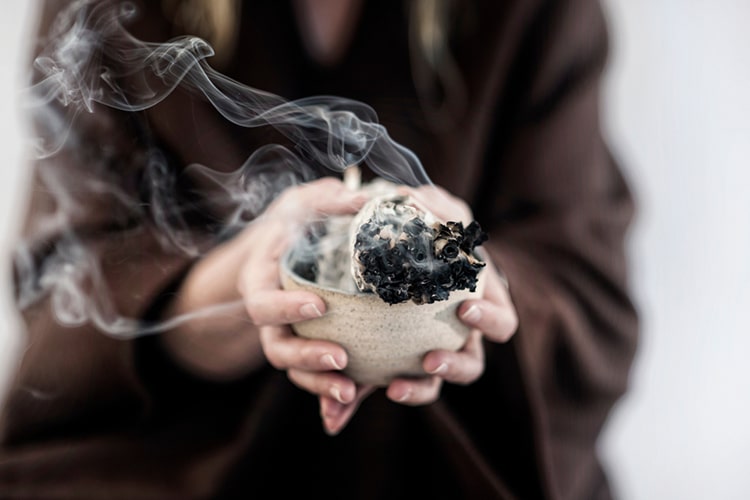Afterpay & ZIP Available
Same-day dispatch on orders before 3pm
10% OFF your first order: WELCOME10
Welcome to a journey through time and tradition, exploring the mystical world of incense and crystals. These ancient practices, steeped in history and rich in cultural significance, have captivated human imagination for thousands of years. From the sacred temples of ancient Egypt to the tranquil meditation spaces of the modern era, incense and crystals have played a pivotal role in spiritual rituals, healing ceremonies, and personal well-being.
In this blog, we delve deep into the origins and history of incense and crystals, tracing their evolution and understanding their ancient history. We will also explore the ancient rituals where incense burning was an integral part, and how crystals, revered for their beauty and power, have been used across various cultures for protection, healing, and spiritual growth.
Join us as we uncover the secrets of these ancient practices and their relevance in our contemporary world.

Incense and crystals have a long history and have been used for different purposes in many forms throughout the centuries. In this detailed guide, we will explore the fascinating history of incense, its significance, and how it is being used today.
Incense has a long and fascinating history, with its origins dating back thousands of years. The discovery of incense and its early use can be traced to ancient civilizations. The history of incense begins in the depths of ancient civilizations. Archaeological evidence suggests that incense was used in ancient Egypt as early as the Fifth Dynasty, around 2345-2494 BC.
In addition, incense was also used for its medicinal purposes, believed to purify the air and ward off negative energies. The smoke produced by burning incense served as a medium through which prayers and offerings were carried to the heavens, making it an integral part of religious and spiritual ceremonies. Incense played a crucial role in religious ceremonies, often used to honor gods and goddesses.
Incense was an integral part of traditional medicine, used for its believed healing properties. Incense burning was a common practice in Buddhist temples, where different fragrances were used to represent various aspects of Buddhist philosophy. The calming aroma of incense smoke was also used to aid in meditation and relaxation, helping to create a tranquil environment.
Throughout history, incense has been used for various purposes across different cultures. In addition to its pleasing aromas, incense is believed to have spiritual and healing properties. It is often used to purify the air and clear negative energies.
The use of incense can be traced back thousands of years to ancient civilizations such as the Egyptians, Greeks, and Romans. One of the earliest mentions of incense burners was found in the Red Sea region, dating back to around 3500 BCE. These burners were made from clay and were used to hold incense during religious ceremonies.
The fragrant smoke of incense was believed to carry prayers to the heavens, creating a sacred space where the divine and human realms met.
In the Arabian Peninsula, incense was more than just a spiritual tool; it was a symbol of wealth and status. The trade routes for incense, particularly frankincense and myrrh, were as significant as the famed Silk Road. These aromatic resins, obtained from the Boswellia and Commiphora trees, were highly prized and used not only in religious rituals but also in embalming practices.
In ancient China, incense was highly regarded and was even used in the imperial court. The Chinese believed that burning incense brought positive energy and created a harmonious atmosphere.
Incense has a long and rich history in India, serving different purposes and taking on various forms. Let’s explore the ancient origins of incense in India and delve into its significance and uses. Incense in ancient India was used for a wide range of purposes. It played a significant role in religious ceremonies, spiritual practices, meditation, and creating a pleasant atmosphere. The fragrant smoke of incense was believed to purify the air and enhance focus during rituals and prayers.
Incense in ancient India was available in various forms. It could be found as sticks, cones, or powdered incense. Incense burners, made from different materials such as clay or metal, were used to hold and burn the incense. These burners often had intricate designs and were considered essential accessories for religious rituals.
In ancient India, a variety of natural ingredients were used to create different types of incense. Some commonly used ingredients included aromatic woods, resins, herbs, spices, and flowers. Sandalwood, known for its calming and soothing properties, was a popular choice. Other scents such as jasmine, rose, and lavender were also used to create pleasing aromas.
The use of incense also spread to other parts of the world. In the Americas, incense was used by indigenous cultures for medicinal purposes and spiritual rituals. The American Philosophical Society has documented the types of incense used by these cultures, which included various scents such as sandalwood, sage, and cedar.
Incense holds a significant place in the traditions and rituals of Native American culture. It has been used for different purposes and comes in many forms, including incense burners, powdered incense, incense sticks, and cones. Let’s delve into the rich history of incense in Native American culture and explore its various forms and uses.
The burning of herbs and incense is a sacred practice in many indigenous cultures, including Native American tribes. It is a ritual for cleansing, purifying, and protecting the physical and spiritual realms. Native Americans have long recognized the power of incense and have incorporated it into their daily lives.
The Romans, too, embraced incense, primarily for its purifying qualities. Incense burners were a common sight in temples and homes, used in rituals to honor the gods and cleanse the air of impurities. The Catholic Church later adopted this practice, and the use of incense became a staple in Christian liturgy, symbolizing the ascent of prayers to heaven.
Incense comes in different forms, including cones, sticks, scented chips, and powdered incense. Each form has its unique way of burning and releasing fragrances. For example, incense cones are compact and burn slowly, while incense sticks are made from bamboo sticks coated with powdered incense.
The choice of incense depends on the desired effect and the purpose of use. Some people prefer essential oils or scented powders, while others opt for loose incense powder or stick incense. The variety of options allows individuals to find the right incense that resonates with their intentions and preferences.its

As incense gained popularity, different forms were developed to enhance its usability and convenience. Different types of incense were created using a variety of raw materials, such as aromatic woods, resins, herbs, and essential oils. These ingredients were carefully selected to produce captivating scents that were believed to have various effects on the mind, body, and spirit. For example, sandalwood, known for its calming properties, was often used in incense blends to promote relaxation and soothe the nervous system.
One of these forms was the cone shape, which allowed for easy burning and produced a concentrated and long-lasting aroma. Another popular form was the incense stick, made by rolling a paste of powdered incense around a bamboo stick. These incense sticks became widely used due to their ease of handling and the ability to control the release of fragrance. They were often crafted in various scents, ranging from floral and herbal aromas to exotic and spicy blends. Additionally, powdered incense and scented chips were also common, providing versatility in creating personalized incense mixtures.
Fast forward to modern times, and the use of incense has transcended religious boundaries. It remains a staple in many religious ceremonies across the world, including in Christianity, Hinduism, and Buddhism. The act of lighting incense, whether it be a stick, cone, or loose powder, continues to be a powerful ritual, signifying the intention to create a sacred space, purify the environment, or simply offer a moment of peace and reflection.
In the realm of wellness and self-care, incense has found a new purpose. Aromatherapy, the practice of using essential oils and fragrant smoke for therapeutic benefit, often incorporates incense. The soothing properties of incense are believed to reduce anxiety and stress, promoting a sense of calm and well-being. From the gentle scent of lavender to the grounding aroma of sandalwood, each incense type offers a unique experience.
Today, the market is flooded with a variety of incense forms, from traditional joss sticks to cone-shaped incense and even aromatic woods. Each type and scent of incense carries its meaning and purpose. For instance, frankincense is often used for purification and spiritual growth, while myrrh is believed to aid in healing and grounding. Incense makers have also started blending different fragrant materials, creating unique scents that cater to a wide range of preferences and purposes.
Burning incense is an ancient practice that is still widely embraced today. It is believed to cleanse the air, create a sacred atmosphere, and evoke a sense of tranquility. The process of burning incense involves lighting the tip of the incense stick or cone and allowing it to smolder. As the incense burns, fragrant smoke is released, filling the space with its aroma.
Different cultures have their unique rituals and ceremonies associated with burning incense. For example, in India, incense plays a significant role in religious ceremonies and prayer. It is also commonly used during meditation and yoga practices.
The use of incense has also extended beyond religious and spiritual contexts. Many people burn incense for its therapeutic benefits, such as reducing stress and promoting relaxation. Certain scents, like lavender or jasmine, are known for their calming effects on the nervous system.

Throughout history, incense has been closely associated with religion. The burning of incense has been an integral part of religious rituals and ceremonies, symbolizing reverence and spiritual connection. The dust-like particles released by burning incense create an ethereal atmosphere, evoking a sense of awe and devotion.
In ancient times, usually a silver lighter was used to ignite the incense, and skilled healers would carefully measure and prepare the incense mixture, ensuring the right proportions of ingredients. As worshippers entered sacred spaces, they would often encounter the sweet aroma of incense, guiding them toward the heart of the ceremony.
One popular form of incense is the coil, which slowly burns and releases fragrant smoke. These coils are consumed over time, creating a mystical ambiance that enhances the religious experience.
It is important to note that incense should be handled with care, as its ashes can be flammable. Additionally, the clothes worn during ceremonies may absorb the lingering scent of incense, serving as a reminder of the sacred rituals performed.
B. Incense as a symbol of purification and spiritual connection
Incense mixtures can include various ingredients such as copal, rosemary, and lemongrass. Copal, in particular, holds significant cultural and religious value. It was believed to have purifying properties and was often used in rites and rituals. The benefits of incense extend beyond its fragrance, as it also plays a role in enhancing meditation and spiritual practices. The essential oils present in incense can linger in the air, promoting a sense of tranquility and calm.
D. Incense and its association with temples and altars
The use of incense can be traced back to ancient times and is mentioned in various religious texts such as the Bible. It holds symbolic significance and serves as a center point for magic and rituals. Incense was often created using natural materials like bark, gemstones, and liquid mixtures, each chosen for their specific properties and effects. The act of burning incense during ceremonial occasions had a profound impact on worshippers, helping to cleanse the space and elevate their spiritual connection.
Different cultures have their unique ways of incorporating incense into their religious practices. In Japan, for example, incense is often placed on a tray and lit during ceremonies. The soft glow and gentle crackling of the burning incense contribute to the serene ambiance of the ritual. It is worth noting that there are different types of incense, including cones, which are called “koh” in Japan. These cones release fragrant smoke when burned, creating a sensory experience that is deeply intertwined with spiritual beliefs.

The allure of crystals is as old as civilization itself. The ancient Egyptians were among the first to extensively use crystals, not just as jewelry but for their supposed protective and healing properties. They often buried their dead with quartz crystals, believing that it would guide them in the afterlife. Lapis lazuli, a deep blue stone, was highly valued for its beauty and was often associated with royalty and gods.
In ancient times, crystals were more than mere adornments; they were imbued with mystical properties. Amethyst, for example, was believed to prevent intoxication, while hematite, associated with Mars, the god of war, was used by soldiers for protection in battle. The Greeks also used crystals in their healing rituals, laying them on the body to promote healing and restore balance.
The fascination with crystals wasn’t limited to their physical beauty or mystical properties. Philosophers and scholars, such as Pliny the Elder and Aristotle, wrote extensively about crystals, trying to understand their origins and properties. This curiosity laid the groundwork for the modern study of mineralogy. The ancient Indian and Chinese cultures also held crystals in high regard, incorporating them into their healing practices and using them to align and balance the body’s energy centers, or chakras.
In today’s world, the use of crystals has seen a resurgence, especially in the realms of spirituality and alternative healing. Many people believe that crystals can help manage stress, heal physical ailments, and promote emotional well-being. Practices such as crystal meditation and crystal healing therapy have become increasingly popular, with practitioners using crystals to cleanse the aura, enhance spiritual awakening, and attract positive energies.
Beyond their spiritual and healing uses, crystals have also found a place in home decor and personal adornment. Their natural beauty and variety of colors make them a popular choice for jewelry, ornaments, and decorative elements in homes and sacred spaces. Crystals like amethyst, rose quartz, and jade are often used to create a peaceful and harmonious atmosphere, believed to attract love, abundance, and positive energy.
The world of crystals is vast and varied, with each type possessing unique properties and meanings. Clear quartz, known as the ‘master healer’, is revered for its ability to amplify energy and thought. Amethyst, with its calming and intuitive properties, is often used for meditation and spiritual work. Citrine is celebrated for its ability to manifest abundance and positivity. Each crystal, with its unique color, composition, and energy, offers a different experience and benefit.

The use of incense and crystals often goes hand in hand in various spiritual and healing practices. Burning incense can cleanse and purify the energy of a space, creating the right environment for working with crystals. Together, they can enhance meditation, aid in spiritual rituals, and create a balanced and harmonious atmosphere. This synergy between incense and crystals is a testament to their power and significance in spiritual and healing practices.
The journey through the mystical world of incense and crystals reveals a rich tapestry of history, culture, and spiritual significance. These ancient practices, deeply rooted in the rituals and traditions of our ancestors, continue to find relevance and resonance in our modern lives. Whether used for spiritual growth, healing, or simply to bring a sense of peace and beauty into our daily lives, incense, and crystals remind us of our connection to the natural world and the ancient wisdom that guides us.
As we continue to explore and appreciate these age-old practices, we invite you to discover the unique ways in which incense and crystals can enhance your spiritual journey and well-being.

Collections
Subscribe
Sign up to our mailing list to get 10% off your first order, find out about new products and weekly sales.
2024 Incensen
Thank you for signing up for Incensen.
Your 10% off code is:
Sign up for our mailing list to get 10% off your first order and learn about new products and sales.